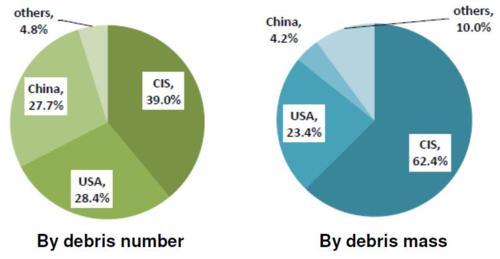
Debris in low Earth orbit (LEO) by number (left) and by mass (right). CIS is the Russian Federation.
I came across an interesting pair of plots recently that shed some light on the space debris problem. China tested an anti-satellite (ASAT) weapon in early 2007 that destroyed one of its defunct weather satellites, creating more than 3,000 pieces of orbital debris larger than 5-10 cm. This is the most debris created by any collision in history. This single event jumped China from owning a very small fraction of the large debris objects in LEO to owning a fraction comparable to the US and Russia, as shown on the left plot above.Here “large objects” refers to debris that can be detected and tracked by the US Space Surveillance Network (SSN). These are typically larger than 5 to 10 cm for objects in LEO, which is what these plots show.
The number of debris particles in orbit is a concern since if these particles collide with a satellite they can damage or destroy it.
The plot on the right shows that the US and Russia together own more than 85% of the debris mass in LEO, while China owns a small slice. This is because these two countries have many more large-mass objects in orbit, like defunct satellites and the rocket stages used to put them in orbit.
These large-mass objects are a concern because they are the potential sources of large amounts of debris in the future, since in a collision these objects could fragment into enormous clouds of debris.
As a result, these are the objects you most want to remove from orbit to reduce the likelihood of large future increases of debris. Removing these objects can be thought of as pulling down large amounts of debris that are currently all in one place.
Figuring out how to remove the large objects in a safe and affordable way is an area of active research. What the plot on the right makes clear is that despite the 2007 Chinese ASAT test, the responsibility for debris remediation—i.e., removing the most problematic debris already in space—is overwhelmingly a US-Russian issue.
